Stirling Moss: The Legend
Sir Stirling Moss was a trailblazer, not just for British motor racing, but in the way he conducted himself and his career. We examine the Moss legacy, and how he continues to hold a special place in motor sport history long after his racing career was cut short

“Motion is tranquility”
That was the motto by which Stirling Moss always lived. But for most of 1962 everything came to an abrupt halt for the-then 32-year-old, when he hit the earth bank at St Mary’s on Easter Monday. The recovery would be long, painful and numbingly frustrating for a man with so much energy for life. But it was also a time for contemplation and introspection, much needed given how foggy his future had suddenly become. Would he race again? And if not, what the hell would he do with the rest of his life?
Since his emergence from the post-war gloom of heavily rationed Britain in 1947, Moss had been a much-needed beacon towards a brighter, modern future. It’s perhaps hard for us younger generations to understand the impact he made as a sportsman, at a time today when Lewis Hamilton somehow seems to be divisive despite (or perhaps because of) his extreme levels of success. In the late 1940s and early 1950s, life was tough – for some, more so than during the war itself.
Yet here was a teenage ‘Boy Wonder’ with a burning talent, ready to take on the continentals in a colourful, deadly and thrilling sport in which Britain for too long had played merely a supporting role. From his successes in 500cc Coopers and that breakthrough Dundrod TT win in a privateer Jaguar XK120 on the eve of his 21st birthday in September 1950, Moss was the man to give a battered country and its tired people new hope. A child during the hostilities, Stirling was, from the start, a man of the modern age.
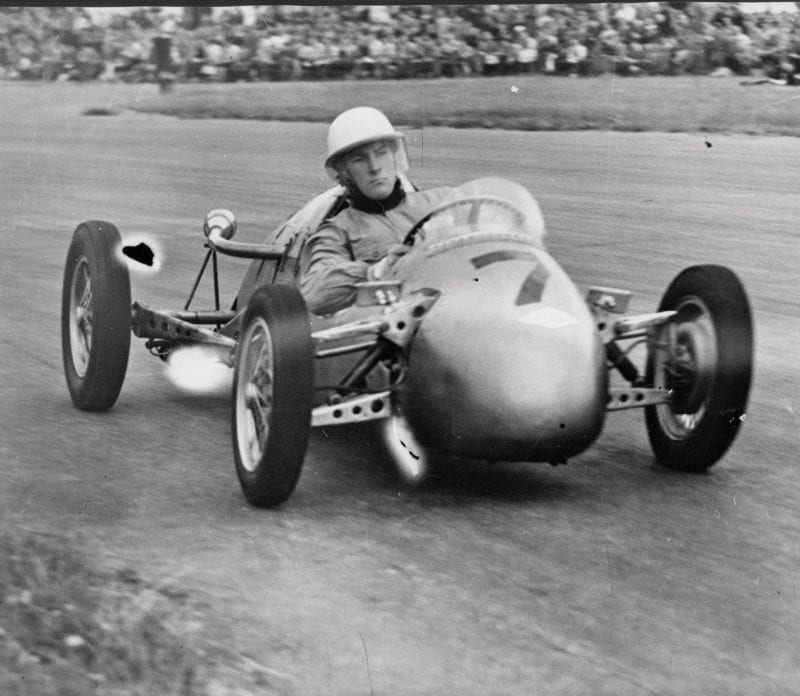
Moss took Norton-powered Kieft 500cc to a British GP support win in 1952
Shutterstock
Yet it was golden-haired Mike Hawthorn who initially led the charge, signing for Ferrari and even beating the new maestro Juan Manuel Fangio in a slipstream thriller at Reims in 1953. Moss, in contrast, was frustrated. Sure, he was still the poster boy, the figurehead of the works Jaguar team in sports cars, but in grand prix racing what hope did he have, given the dearth of top drives? Even Formula 1 itself had been forced to revert for two seasons to Formula 2 regulations, given the lack of top-line teams.
Moss was lucky he came from the right family. How different was he really to young drivers today who rely on parents to push them up the eye-wateringly expensive lower rungs of the single-seater ladder? In 1954, his father Alfred Moss, himself a successful racer and a well-off dentist, and manager Ken Gregory felt compelled to buy the boy a new Maserati 250F – at £5500, the equivalent of a Spitfire 10 years earlier – as the only way left open to show the world what Stirling was truly capable of. The investment paid off – this was Moss, after all – and by 1955 he was a factory Mercedes-Benz driver, in thrall to but by no means overawed by his team-mate Fangio.
“Moss was more polished, focused and professional”
For the next four years, Moss would drive the world’s finest grand prix cars, first Mercedes, then Maserati once more but now as a full factory driver, then on to emerging Vanwall. Each year, he would finish in frustration as F1 World Championship runner-up, but while it was Hawthorn who would edge the race to become the first British champion in 1958, aided by Moss’s towering sportsmanship in Oporto, most of Britain knew which sportsman was pointing towards the future. Even in the 1950s Hawthorn was a throwback, with his bow tie and Mon Ami Mate high-jinks. Moss, while far from averse to late nights and the chasing of ‘crumpet’, was more polished, more focused and more professional. In sport, at a time when England still valued the talented amateur, that was often a dirty word, but as Stirling knew, racing drivers put more on the line than footballers and rugby players. If he was going to risk his life, the least he expected was a decent living, in line at the time with that of a top lawyer.
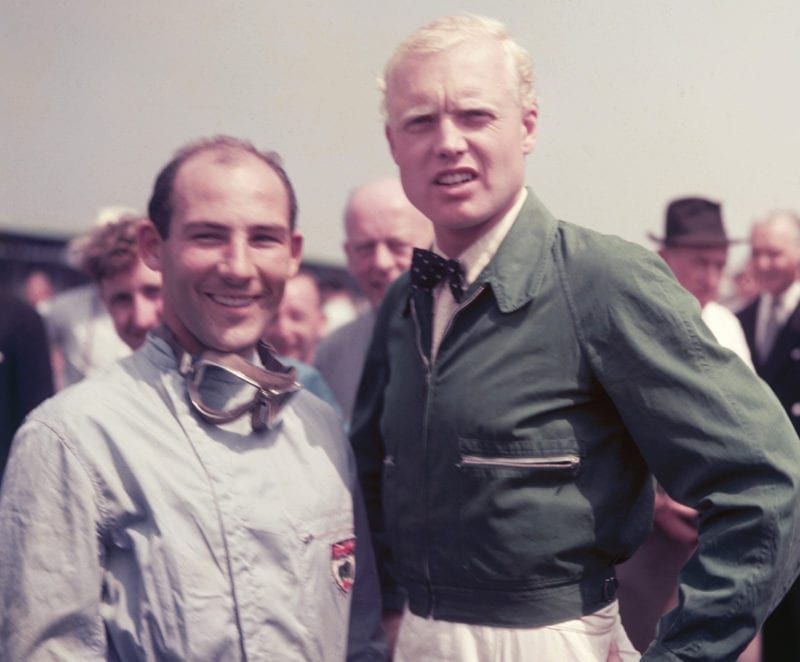
Moss with 1958 title rival Hawthorn
Getty
After the title loss of 1958 and Vanwall’s withdrawal, hindsight shows a significant shift in Moss’s attitude and approach to racing. Always a patriot, he now chose who he drove for based on nationality, loyalty and friendship. As a patron, Rob Walker was hard to fault – but as a privateer, inevitably there were limitations to his outfit. Still, it was Moss, not Jack Brabham, that would first win a grand prix in a rear-engined Cooper; and Moss and Walker, not Colin Chapman’s works team, that would deliver Lotus its first victory.
By 1962, Stirling was still at the top of his game and still the benchmark despite that lack of an F1 title. At Goodwood, he was driving for Gregory’s UDT-Laystall Racing Team in Walker’s loaned Lotus 18/21. It was far from unusual for Moss to be driving an outdated car, but this was an occasion to try the new Coventry-Climax V8 upon which so much rode that season. The mash-up hybrid had misfired at Snetterton, so here they were at The Glover Trophy to try again, in another race where the stakes were relatively low…

Racing the Aston Martin DB3S in ’56 Daily Express International Trophy
Getty
Here is an eyewitness account of what happened on that fateful day, from my then 15-year-old father. “We were at the top of the Lavant Straight,” he recalls. “When he came past us he had a misfire and then pitted. But when he came back out again, the V8 had cleared.” Moss had lost two laps, apparently to fix a jamming gear selector on the Colotti gearbox, but Stirling being Stirling was pressing on regardless for the fastest lap when he encountered leader Graham Hill at St Mary’s. “All we saw over there was a big cloud of dust and dirt. When he didn’t come round behind Graham Hill, we realised it was Moss.”
“It took 45 minutes to cut Moss from his Goodwood wreck”
The rescue began, as was common back then, while the race droned on [you can read a first-hand account from a first responder on our Letters page]. It took 45 minutes to cut him from the wreck, BRP’s Tony Robinson and Stan Collier removing the battery and fuel tank over his legs, relieved at least that fire hadn’t increased the urgency. “The ambulance came past us ringing its bell behind a course car, and we could still hear it out on the road as it headed for Chichester,” Dad remembers. “We could tell it was bad. What a very sad day.”
From Chichester Hospital, he was transferred early on the Tuesday to the Atkinson Morley Hospital in Wimbledon, where he would be treated and convalesce for the next 13 weeks. The head injuries were the biggest concern: he had massive bruising to the left-hand side of his brain, which had become partially detached from his skull, and his left eye socket was crushed. There was also a broken leg and arm to be dealt with, although he knew nothing of those early weeks. Moss only properly regained consciousness 38 days later. Then at first he was partially paralysed and couldn’t speak. His star that had burned so bright just a few days previously looked to have been extinguished. Which raises the question of just how Moss not only recovered but went on to cement his legend as Britain’s greatest racing driver.
A book first published in 1963 offers a fascinating insight into Moss’s mindset at this time. All But My Life by Ken W Purdy wasn’t so much a biography, but more a contemplation on life, motor racing, women and death. The ‘interviews’ (they’re conversations more than anything) capture a portrait of a man in transition from one life to the next.

Moss won Monaco ’56 in a Maserati, two years before a famous Aintree win (below)
Getty

GP Library
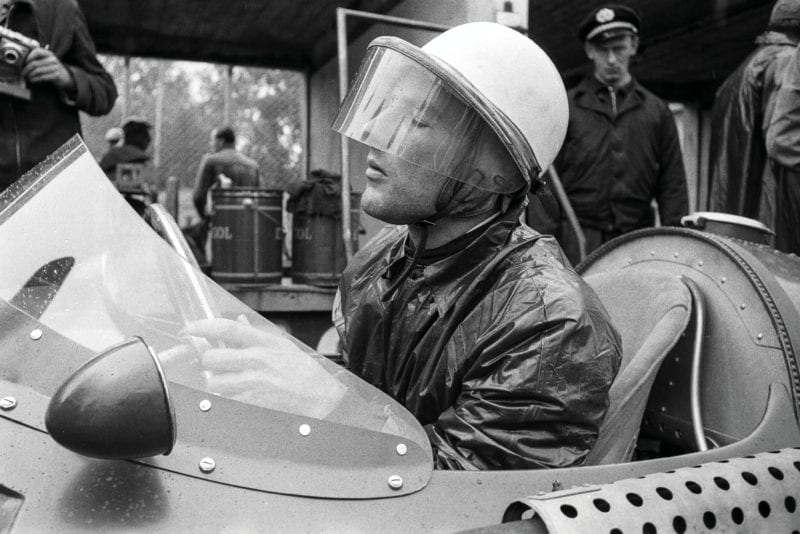
Moss set to practice for the ’56 German GP; he would take second in the race
Getty
One offers some understanding into why Moss was prepared to race almost anything, on any given day: “Racing is rather like painting to me: the car is only the instrument, as paints are to a painter. All right, one car is better than another, fine, and one kind of paint is better than another, very well, but it really doesn’t matter, the painter creates with whatever he has at hand, and if he hasn’t anything better he’ll use a child’s set of crayons. Give Picasso a broken two-shilling set of crayons, and he’ll give you something worth two thousand pounds. After all, I think driving is an art. I really do maintain that.”
“Racing is like painting to me: the car is only the instrument”
A page over, Moss dispels the notion that it was all about the money. Purdy makes the point that grand prix racing carries the biggest rewards. “I’m as greedy as the next man, but that’s not enough reason,” Stirling shoots back. “A professional is a driver who races out of pride. He wants to win because he wants to beat you, not just to get the extra few dollars or pounds or francs, or whatever. I don’t know anyone racing today… purely for money.”
Stirling also tackles his lack of an F1 world title head-on: “People ask: ‘Aren’t you upset about not being World Champion? Doesn’t it bother you, that you were runner-up five times [sic: in fact four times – 1955-58]?’ And the answer is, in honesty, that the first year I was pretty much upset, it would be correct to say, very much upset. But the disappointment got less each time. Partially it was just conditioning, a second disappointment is easier to bear than the first, a third is easier than the second. Partially it was something else, even now I’m not sure what it was, but I might say it was the realisation that while having the championship would mean perhaps a lot to Stirling Moss Limited, it might not mean much to Stirling Moss. Do you understand?”
Then the killer lines: “Because I’d rather go down in history as the man who never won the championship, than as the man who won it once. If I won it once, what of that? Mike Hawthorn won it once. If one wins it twice, does that mean one is a better driver than Mike? I think Mike Hawthorn was a splendid person, he did a lot for motor racing, I liked him, and I very much indeed wish he were still with us. But I didn’t consider him a very consistent driver. When he had an ‘on’ day he was very, very good. If he liked a circuit, as he liked Reims – Mike really did feel that Reims was his personal property – right, he’d beat Fangio himself on it. If he didn’t like a race, and he didn’t like the tough ones, the Mille Miglia, the Targa Florio, Sebring, he wasn’t mad keen on the Nürburgring either, he’d either not run in it or he’d stroke it. I had more respect for Mike as a man than as a driver.”
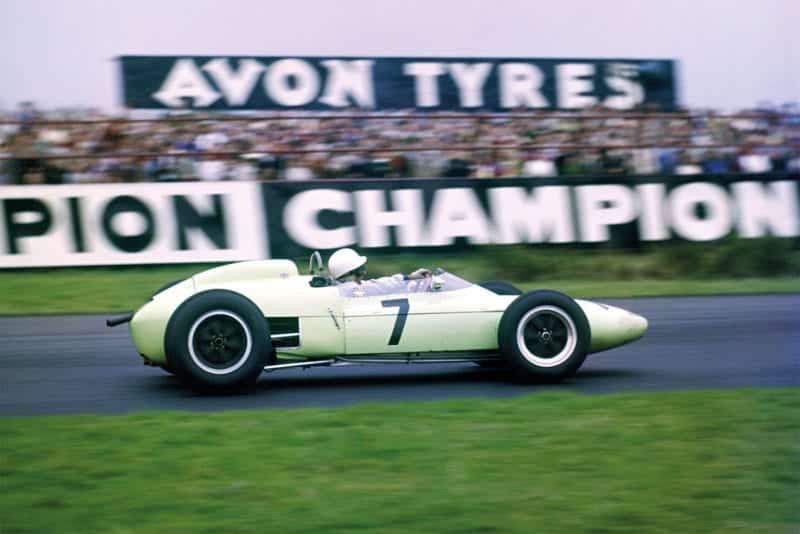
Fateful ’62 Goodwood race: the career-ending crash was never explained
GP Library
There’s more, and a view that might offer the likes of Fernando Alonso some consolation. “So Mike won it once, and Phil Hill won it once, and Graham [Hill] won it once [twice by 1968], and Jack Brabham won it twice [three times by ’66]. Do I have to win it three times to prove I’m a better driver than Jack is? Fangio won it five times. If I won it six times, wouldn’t that make me a better driver than Fangio? No, it wouldn’t. Winning it six times won’t make me as good a driver as Juan Manuel Fangio, and winning it 10 times wouldn’t make me a better driver, because I’m not. Fangio was better than I was, and that’s that.”
On May 1, 1963, a little over a year after the accident, a bearded Moss returned to a damp Goodwood to try a BRP Lotus 19 sports racer. St Mary’s was no problem, there were no flashbacks or anything unpleasant. But he came away that day certain his driving career was now over. The things he had subconsciously been able to do on instinct now required effort, and he could feel it was taking more out of him. It wasn’t the same. In the years to come, he would reflect on that day and admit he’d tried too soon, that his judgement had been too sharp.
But to his credit, and in a manner that Jackie Stewart would understand, once the decision was taken, he’d stick to it. Stirling Moss was now an ex-racing driver.
“Moss would reflect he’d tried too soon to make a comeback”
But somehow for the next five decades, he would remain ‘Mr Motor Racing’. The old joke about the policeman saying “Who do you think you are, Stirling Moss?” was never swapped for Graham Hill or Jimmy Clark or John Surtees or Jackie Stewart or James Hunt or Nigel Mansell or Damon Hill or Lewis Hamilton – despite their world titles. Moss was the first of his breed to make a great deal of his living from being an ex-professional sportsman.
Remember the turgid James Bond spoof Casino Royale, starring Peter Sellers, David Niven and a young Woody Allen from 1967? It was Stirling who played the cameo (“Follow that car!” barks Sellers, and Stirling obliges – running off on foot). He’s also the only real person to be written into Ian Fleming’s Bond stories – or at least the notes for an unpublished short story. In Murder on Wheels, Bond travels to the fictional Nurbering in Switzerland to stop SMERSH agents sabotaging a race and killing Moss while making it look like an accident. 007 is trained to drive the Maserati by Moss himself, then takes over for the race and defeats the agents, thereby saving Moss’s life…
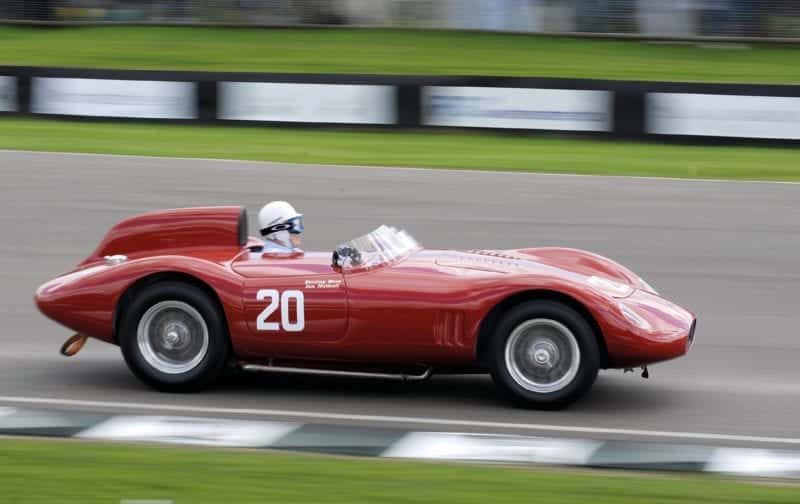
Moss in a ’56 OSCA in the 2010 Goodwood Revival’s Madgwick Trophy race
Getty
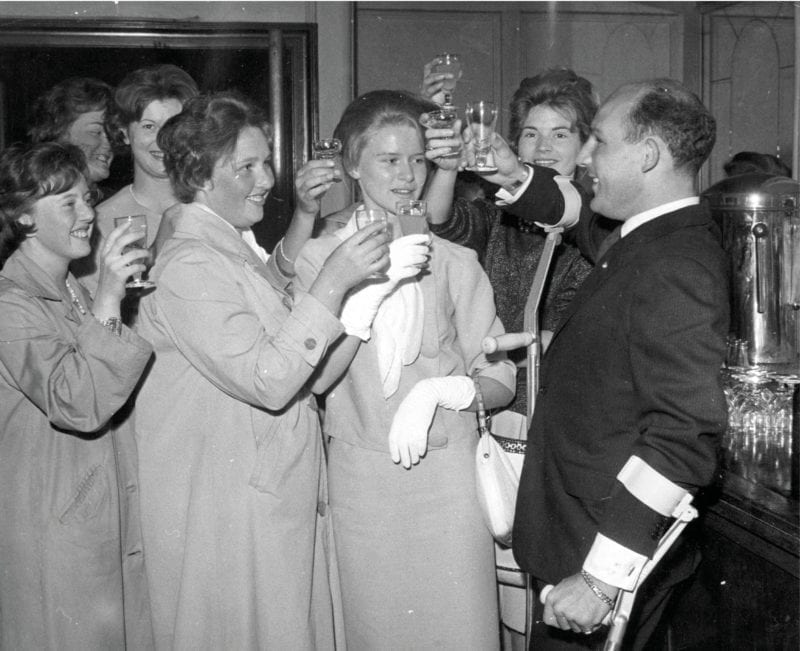
Moss raises a glass to the nurses who aided his recovery from his Goodwood injuries
Getty
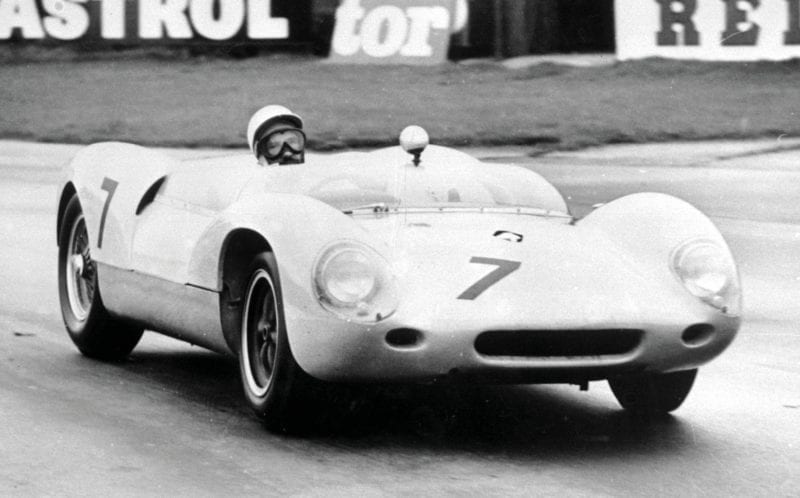
After recovering, Moss tried a Lotus 19 at Goodwood. It would confirm his retirement call
PA
That’s just one indication of how famous he was, and perhaps why he still meant something to a wider public who generally admired him (when he didn’t say something sexist about female racing drivers). Those of us devoted to motor racing knew why he was special, which is why he would remain the biggest draw wherever he would appear. That distinctive name helped him stand out, too. Just as well his mother didn’t get her wish in calling him Hamish…
But his relationship with the public was not always straightforward. Inherently a deep man, he wasn’t always comfortable being the focus of attention and his patience could be short. And yet he played his part as national treasure and hero to many, with all the grace he exhibited as a racer in his pomp. As he told this magazine at the time of his 80th birthday in 2009, when his racing career was over Stirling thought that as a man with no formal qualifications he had only two alternative career choices: estate agent or MP.
He got closer to the former (imagine if he had chosen the latter…), investing in properties around his native London and famously managing his tenants and their menial problems personally. Those investments, coupled with his life as ‘Mr Motor Racing’, served him well until the inevitable creep of mortality forced him into retirement.
‘Motion is tranquility’. That motto rang true to the end.
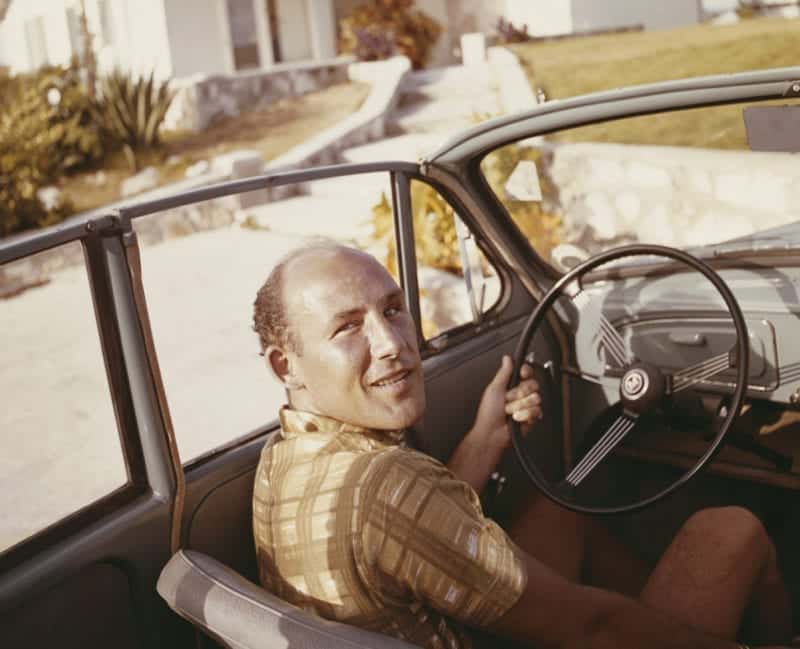
Moss during his recuperation, sitting at the wheel of a Morris Minor in the Bahamas
Getty
